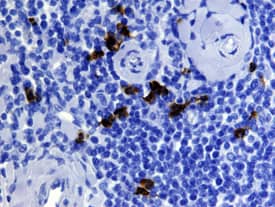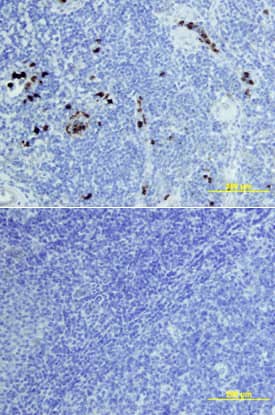Human EN-RAGE/S100A12 Biotinylated Antibody
R&D Systems, part of Bio-Techne | Catalog # BAF1052


Key Product Details
Species Reactivity
Validated:
Human
Cited:
Human
Applications
Validated:
Flow Cytometry, Immunohistochemistry, Western Blot
Cited:
ELISA Development, ELISA Development (Detection)
Label
Biotin
Antibody Source
Polyclonal Goat IgG
Product Specifications
Immunogen
E. coli-derived recombinant human EN‑RAGE/S100A12
Met1-Glu92
Accession # P80511
Met1-Glu92
Accession # P80511
Specificity
Detects EN‑RAGE/S100A12 in Western blots.
Clonality
Polyclonal
Host
Goat
Isotype
IgG
Scientific Data Images for Human EN-RAGE/S100A12 Biotinylated Antibody
EN-RAGE/S100A12 in Human Tonsil.
EN-RAGE/S100A12 was detected in immersion fixed paraffin-embedded sections of human tonsil using 10 µg/mL Goat Anti-Human EN-RAGE/ S100A12 Biotinylated Antigen Affinity-purified Polyclonal Antibody (Catalog # BAF1052) overnight at 4 °C. Tissue was stained with the Anti-Goat HRP-DAB Cell & Tissue Staining Kit (brown; Catalog # CTS008) and counterstained with hematoxylin (blue). View our protocol for Chromogenic IHC Staining of Paraffin-embedded Tissue Sections.EN-RAGE/S100A12 in Human Tonsil.
EN-RAGE/S100A12 was detected in immersion fixed paraffin-embedded sections of human tonsil using Goat Anti-Human EN-RAGE/S100A12 Biotinylated Antigen Affinity-purified Polyclonal Antibody (Catalog # BAF1052) at 10 µg/mL overnight at 4 °C. Tissue was stained using the Anti-Goat HRP-DAB Cell & Tissue Staining Kit (brown; Catalog # CTS008) and counterstained with hematoxylin (blue). Lower panel shows a lack of labeling if primary antibodies are omitted and tissue is stained only with secondary antibody followed by incubation with detection reagents. View our protocol for Chromogenic IHC Staining of Paraffin-embedded Tissue Sections.Applications for Human EN-RAGE/S100A12 Biotinylated Antibody
Application
Recommended Usage
Flow Cytometry
2.5 µg/106 cells
Sample: Human whole blood monocytes
Sample: Human whole blood monocytes
Immunohistochemistry
5-15 µg/mL
Sample: Immersion fixed paraffin-embedded sections of human tonsil
Sample: Immersion fixed paraffin-embedded sections of human tonsil
Western Blot
0.1 µg/mL
Sample: Recombinant Human EN-RAGE/S100A12 (Catalog # 1052-ER)
Sample: Recombinant Human EN-RAGE/S100A12 (Catalog # 1052-ER)
Formulation, Preparation, and Storage
Purification
Antigen Affinity-purified
Reconstitution
Reconstitute at 0.2 mg/mL in sterile PBS.
Formulation
Lyophilized from a 0.2 μm filtered solution in PBS with BSA as a carrier protein.
Shipping
The product is shipped at ambient temperature. Upon receipt, store it immediately at the temperature recommended below.
Stability & Storage
Use a manual defrost freezer and avoid repeated freeze-thaw cycles.
- 12 months from date of receipt, -20 to -70 °C as supplied.
- 1 month, 2 to 8 °C under sterile conditions after reconstitution.
- 6 months, -20 to -70 °C under sterile conditions after reconstitution.
Background: EN-RAGE/S100A12
References
- Santamaria-Kisiel, L. et al. (2006) Biochem. J. 396:201.
- Leclerc, E. et al. (2009) Biochim. Biophys. Acta 1793:993.
- Wicki, R. et al. (1996) Cell Calcium 20:459.
- Moroz, O.V. et al. (2009) BMC Biochem. 10:11.
- Miranda, L.P. et al. (2001) FEBS Lett. 488:85.
- Vogl, T. et al. (1999) J. Biol. Chem. 274:25291.
- Xie, J. et al. (2007) J. Biol. Chem. 282:4218.
- Goyette, J. et al. (2009) J. Immunol. 183:593.
- Hatakeyama, T. et al. (2004) Eur. J. Biochem. 271:3765.
- Hofmann, M.A. et al. (1999) Cell 97:889.
- Yang, Z. et al. (2001) J. Leukoc. Biol. 69:986.
- Rouleau, P. et al. (2003) Clin. Immunol. 107:46.
- Yan, W.X. et al. (2008) J. Biol. Chem. 283:13035.
- Yang, Z. et al. (2007) J. Allergy Clin. Immunol. 119:106.
- Mikkelsen, S.E. et al. (2001) J. Neurochem. 79:767.
- Fuellen, G. et al. (2004) OMICS 8:334.
Long Name
Extracellular Newly Identified RAGE-binding Protein
Alternate Names
CAAF1, CAAFI, CAGC, CAGCS100, Calgranulin C, ENRAGE, MRP6, S100A12
Entrez Gene IDs
6283 (Human)
Gene Symbol
S100A12
UniProt
Additional EN-RAGE/S100A12 Products
Product Documents for Human EN-RAGE/S100A12 Biotinylated Antibody
Product Specific Notices for Human EN-RAGE/S100A12 Biotinylated Antibody
For research use only
